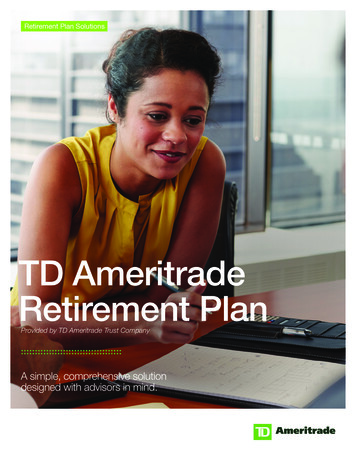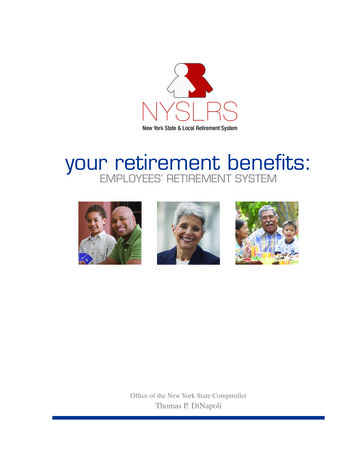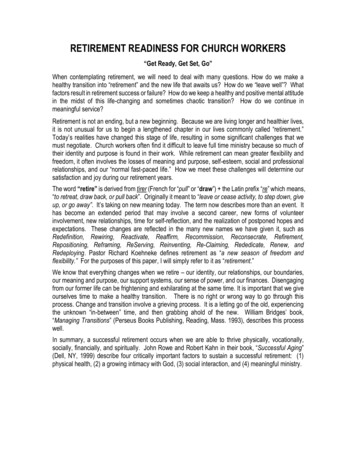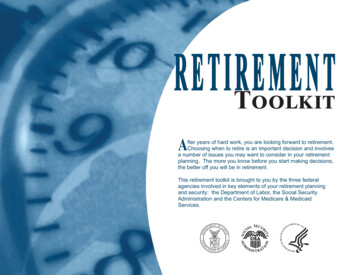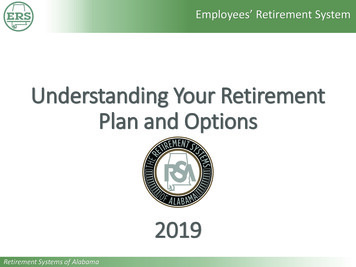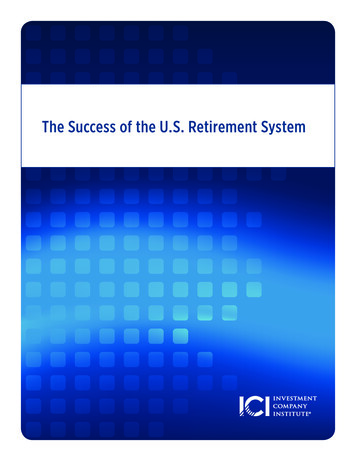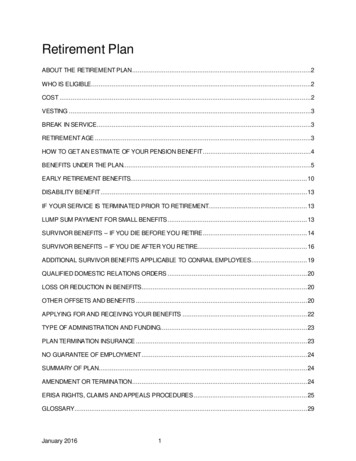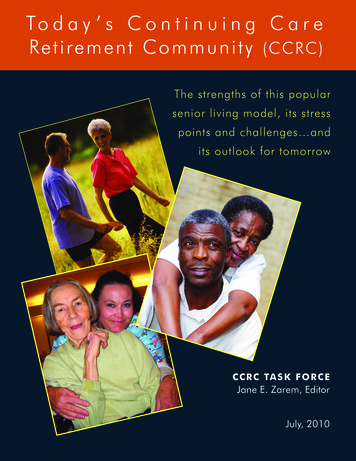
Transcription
To d a y ’ s C o n t i n u i n g C a r eRe t i r e m e n t Community ( C C RC)The strengths of this popularsenior living model, its stresspoints and challenges andits outlook for tomorrowC C R C TA S K F O R C EJane E. Zarem, EditorJuly, 2010
To d a y ’ s C o n t i n u i n g C a r eRetirement Community (CCRC)The strengths of this popular senior living model,its stress points and challenges and its outlookfor tomorrowThis paper was developed by a task force of CCRC executives of bothnot-for-profit and for-profit communities, consultants, financial advisorsand attorneys in cooperation with LeadingAge (formerly AAHSA), AmericanSeniors Housing Association and National Investment Center.
1Table Of ContentsI. A Snapshot of Today’s CCRC. 4 Brief history. 4 Resident service agreements. 6 Entrance fees and refunds. 8 Accommodations and services. 10 Resident demographics. 12II. Financial Strength of the CCRC Model. 16 Financial ratios. 17 Rating agencies. 19 Third-party oversight and governmentregulations. 20III. Weathering the Economic Storm and Moving Forward. 20 Maintaining strength. 21 External forces/internal challenges. 21 Operations stress points . . 23 Covenant violations and payment default issues. 23 Future outlook. 26
2Executive SummaryCCRCs Offer Seniors An Attractive Lifestyle OptionFor many decades, Continuing Care Retirement Communities (CCRCs) have offeredolder adults (usually age 65 and older) an innovative and independent lifestyle thatdiffers from other housing and care options. CCRCs are especially attractive to seniorsmaking decisions for their long-term care future. They allow seniors to convert homeequity or other assets into housing and to receive daily living services and health care ina way that keeps monthly expenditures more stable. Today, sponsors include religious,fraternal and community organizations, universities, hospitals, and companies dedicatedsolely to the development and operation of senior living communities.CCRCs Offer a Range of Services and Entrance-Fee OptionsEmerging from traditional religious and community-based models, CCRCs have evolvedand diversified dramatically since the mid-1980s, offering consumers more service packages and entrance-fee options. CCRCs generally feature a combination of independentliving apartments and/or cottages and nursing care, and many offer assisted living,memory support care, and other specialty care arrangements. They also provide residents with 24-hour security, social and recreational activities, attractive dining options,housekeeping, transportation, and wellness and fitness programs.After many decades, CCRCs continue to remain a very attractive lifestyle option forseniors because of the unique features they offer, including: Secure private accommodations and common area amenities in a variety ofstyles and with a wide range of pricing options; A continuum of services at a single location, including dining, housekeeping,social and recreational programs, transportation, and health-care services, asneeded; Payment plans that may utilize home equity to help keep monthly expenses at alower level and that may offer repayment of a portion of the entrance fees; Possible income-tax deductions in the form of a medical expense deduction forcertain fees paid to the CCRC; and, most importantly, Protection against the loss of accommodations and services if the resident exhausts his or her funds.In response to the changing financial preferences of seniors, residents have their choiceof several entrance-fee alternatives—from the traditional entrance-fee refund, whichusually fully amortizes in 4 to 6 years, to refundable option plans ranging from 50%to 100%. Refunds may be conditioned upon re-occupancy of the resident’s vacatedapartment or may be repaid within a fixed period of time after the resident vacatesthe apartment.
3CCRCs Practice Financial DisclosureCCRCs are financially complex and often incorporate actuarial principles into theirpricing methodology. They also cover a wide range of housing, hospitality, andhealth-care services, with different staffing, physical plant, and utilization parametersfor each. The trend has been to greatly expand the level and detail of disclosure givento residents and prospective residents. This has led to lengthy and detailed contractsthat, in turn, have sometimes led to confusion by some consumers in fully understanding the various financial requirements and obligations of the CCRC. While financialdisclosure regulations vary by state, most require disclosure of key contract and financial terms; others have more comprehensive regulations related to the sales process,reserve requirements, and changes in fees.CCRCs Weather the Financial StormVirtually every business in every sector of the economy has been affected by the slumpin the housing market, and the CCRC market is no exception. But moving to a CCRCis a decision made after careful planning—not one made in desperation due to anurgent health-care need. Many consumers today are waiting for the home resalemarket to improve before making a decision to sell their homes and move to a CCRC.Despite the weak housing market, though, most CCRCs remain fundamentally strongand financially sound. Those CCRCs that face continuing challenges tend to have a“dated” campus, never achieved full occupancy prior to the economic downturn, arestill in start-up, or have a project in the development queue. Some among this grouphave decided to merge or affiliate in order to gain access to larger, stronger organizations; others under stress are working hard to find appropriate solutions for theirorganizations.Current residents of CCRCs are keenly aware of the fact that management’s abilityto fill a vacant unit directly affects the ability of a CCRC to operate on a sound financial basis and the level of fees that residents must pay in order for the operation toremain sustainable. Financial failures have been relatively rare; and even in cases ofbankruptcy, a new provider usually takes over the CCRC’s operations, ensuring thatresidents can remain in their apartments. In past CCRC insolvencies, the lenders andinvestors were most likely to suffer financial loss and not the individual residents. Because many CCRCs are financed with long-term debt, lenders and investors have along-term interest in the health of the CCRC and often establish covenants (financialrequirements) in order to ensure its long-term financial health. Covenant violationsusually do not result in payment default if the community follows the procedures outlined in the financing documents, which typically include communicating the problemto stakeholders as early as possible, following the recommendations detailed in arequired management consultant’s report, and correcting the problems within aspecified period of time.
4I. A Snapshot of Today’s CCRCA CCRC is a residential alternative for older adults (usually age 65 and older) that provides flexible housing options, a coordinated system of services and amenities, and acontinuum of care that addresses the varying health and wellness needs of residents asthey grow older. The emphasis of the CCRC model is to enable residents to avoid havingto move—except, perhaps, to another level of care within the community—if their needschange and they require health care and supervision. Remaining within the communityallows the residents to continue their existing relationships with a spouse and friends,avoid the stress of a move, and receive health care, should it be needed, in an environment they know and trust.A CCRC typically includes apartment or cottage living units (independent living), assistedliving units, and skilled nursing care in a campus-style setting. Residents have lifetimeaccess to the community’s continuum of care. Typically, all of the living options (independent living, assisted living, and nursing) of the CCRC are on a single campus. As careand services for older adults continue to evolve, CCRCs have been adding additionalcomponents, such as memory support and wellness programs, to their services mix.The CCRC’s services and associated charges are contained within a contract that specifiesif and how charges will change as a resident’s health and social needs change overtime. An estimated 65% to 75% of CCRCs offer contracts that include a lump-sum initialpayment (entrance fee), and the large majority of these offer some degree of refundabilityor repayment of the entrance fee to the resident if the resident moves out of the community or to the resident’s estate if the resident dies. The amount of the entrance fee typicallyvaries based on the size and type of living unit. Residents also pay a monthly fee. Theentrance fee, if required, and monthly fee give the resident the right to live in his or herunit and receive services such as meals, housekeeping, repairs and maintenance, andthe use of community facilities, activities, and other amenities. Access to limited orunlimited medical and nursing care may be included in the monthly fee or available ona fee-for-service basis, depending on the contract. While most CCRCs offer one contracttype, some offer two or three and a range of refund options. Brief historyThe CCRC model has evolved over a very long period of time, with some dating backmore than a century. In fact, 25 of LeadingAge Ziegler 1001 senior living systems operateCCRCs that were founded more than 100 years ago. Some CCRCs in operation todayevolved from nursing homes and tend to have a higher number of nursing beds;others were originally built as a CCRC (i.e., “purpose-built”) and were designed with aproportionally greater number of independent living units. Since the 1960s, CCRCs have1LeadingAge Ziegler 100 is an annual publication ranking the largest not-for-profit multi-site senior livingorganizations by their market-rate units.
5experienced steady growth—both in their sheer numbers and in their delivery of services across a wide variety of geographic (urban vs. rural) and demographic (modestvs. upscale and vigorous vs. frail) populations.The first major growth period for the purpose-built CCRC was during the 1970sand early 1980s, as new contract types emerged that attracted prospective residents.Growth of the purpose-built CCRC slowed during the 1980s, when a number ofdefaults occurred primarily due to unsophisticated lending practices and inexperienced developers common to a nascent industry (the purpose-built CCRC model wasstill “young”). By the mid-1980s, for-profit organizations became more involved in thedevelopment of CCRCs. Even so, not-for-profit organizations, often with faith-basedaffiliations and/or catering to affinity groups, still sponsor the majority of CCRCs. Onlyabout 18% of the CCRCs currently in operation have for-profit ownership, accordingto the Ziegler National CCRC Listing and Profile, a report published by ZieglerCapital Markets in November 2009.The period from 1990 through the mid-2000s was characterized by the addition of10 to 20 new communities per year—due to increasing sophistication by CCRC operators and the lending community, as well as increased access to capital from banks andinstitutional investors. The growing financial strength of CCRCs led to the first creditratings for CCRC debt.The period from 2008 to the present has been a time of sharply declining new construction in response to capital constraints, the challenges of the housing market, andgeneral caution with regard to the overall economic climate.Today, there are approximately 1,9002 CCRCs in the United States, located in 48 statesand the District of Columbia. Pennsylvania, Ohio, California, Illinois, Florida, Texas,Kansas, Indiana, Iowa, and North Carolina boast the greatest number (ranked in thatorder). The majority of CCRCs in operation today were purpose-built. Roughly half arefaith-based; a university, health system, military group, or fraternal organization maysponsor others; and a small number have emerged from interested citizens who havecome together with the sole common interest of establishing a CCRC. Whether theyare for-profit or not-for-profit entities, the majority of CCRCs today are part of a multisite system.32The Ziegler National CCRC Listing & Profile, 2009 lists a total of 1,861 CCRCs. For purposes of thispublication the round number of 1,900 will be used.3Ziegler National CCRC Listing & Profile, 2009
6CCRC facts A CCRC may have not-for-profit sponsorship (82%) or for-profit ownership (18%). Approximately half of all CCRCs are affiliated with faith-based organizations;among those affiliations, 21.1% are Lutheran, 17.6% are Methodist, 13.8% arePresbyterian, and 12.8% are Roman Catholic. A CCRC may be a single-campus organization or part of a system; the majorityare part of a system. A typical CCRC has fewer than 300 total units; about one-third have more than300 units; only 8% have more than 500 units. CCRCs are located in a range of geographical areas from urban to suburbanto rural.—Source: Ziegler National CCRC Listing & Profile, 2009The capital markets have increasingly looked to experienced developers to guide development of the CCRC model. Some are for-profit developers who have specialized inthe senior living sector. Others are not-for-profit organizations that have acquired thisexpertise and develop communities for both their own and unrelated organizations. Intoday’s capital markets, it is rare for a CCRC to be developed by an entity unknown tothe sector. While most CCRCs (whether for-profit or not-for-profit) are self-managed,approximately 15% use an outside manager. Management relationships oftenemerge from faith-based roots, as well. Resident service agreementsA number of the more than century-old CCRCs had their roots in residences establishedto meet the needs of widows and orphans resulting from the casualties of the Civil War.The needs of the elderly were heightened during the Depression, and “old age homes”sponsored by faith-based, not-for-profit organizations emerged as a response. Contracts in those early days of the CCRC (if contracts existed at all) required prospectiveresidents, as a condition of moving in, to turn over their assets in return for a promise ofcare for life, highlighting the trust level and expectation among these early CCRC residents that the move was a commitment for the remainder of their lives.Today, CCRCs and the individual or couple entering the community also enter into aformal contract or resident service agreement that details the charges, along with thelevel of services that will be provided either at and/or by the community. Most newCCRC residents begin by living in an apartment or cottage, and the community mayoffer an entrance-fee contract, rental contract or, in relatively rare cases, an ownershipoption for those living accommodations.
7Entrance-Fee CCRCs. When the CCRC model began growing in the 1960s and 1970s,entrance-fee CCRCs typically provided an extensive resident service package thatincluded little (if any) additional charge if the resident transferred to areas of the community that offered higher levels of care. As CCRCs evolved, additional contract typeswere developed to provide choice for prospective residents and options for the providers. Today, the type of contract available to a prospective resident may depend on hisor her health condition or history and the related risk of overutilization of healthservices.The entrance-fee contracts that CCRCs currently offer residents usually fall into one ofthe following categories:Life-care (extensive) contract (Type A)This is the original full-service contract in which individuals (or couples) agree topay an entrance fee and ongoing monthly fees in exchange for living accommodations and an extensive range of services and amenities. A Type A contract generally provides for a resident’s transfer to the appropriate level of care—assistedliving or nursing, either on-site or accessible off-site—for an unlimited time at littleor no additional cost. The CCRC bears the majority of the financial burden of theresident’s long-term care.Modified contract (Type B)With this type of contract, the resident pays an entrance fee and ongoing monthlyfees for the right to stay in an independent living unit and receive certain servicesand amenities. The Type B contract obligates the CCRC to provide residents withappropriate assisted living or nursing care for a specified number of days at noextra charge and/or at rates that are discounted from those charged to thoseadmitted from outside the CCRC. The number of covered days and/or the discountvaries from community to community. The CCRC bears the financial burden of theresident’s long-term care during the covered period; thereafter, the financial responsibility for long-care shifts to the resident, who must pay the regular per-diemrate charged to those admitted from outside the CCRC.Fee-for-service contract (Type C)Fee-for-service continuing-care contracts require an entrance fee and ongoingmonthly fees but do not include any discounted health-care or assisted livingservices. Rather, the resident receives priority or guaranteed admission for theseservices, as needed, but must pay the regular per diem rate paid by those admittedfrom outside the CCRC. With this type of contract, the resident bears the financialburden of his or her additional long-term care needs. The charges will vary, depending upon the services needed.
8The pricing of a CCRC’s entrance fees and monthly fees is typically accomplishedthrough actuarial analysis. Because the Type A and Type B contracts include all or aportion of the resident’s long-term care needs, the entrance and monthly fees may behigher than a Type C contract offered by the same CCRC. Also, a portion of the feespaid by the resident may be available as a medical deduction.Rental CCRCs. Residents of rental CCRCs pay no entrance fee (other than a possible security deposit plus, typically, the first and last months’ fees) at the time they occupy theirapartment or cottage unit. They pay the prevailing market rate for any care required.This type of contract, like the fee-for-service entrance-fee contract, includes no coveragefor the cost of assisted living or nursing services, but offers the resident the lowest level ofupfront expense.Benevolence care. For many CCRCs, providing support for residents who qualify forfinancial assistance or who run out of funds is viewed as a fulfillment of the organization’s mission and purpose. These CCRCs will typically evaluate the financial status of aprospective resident in order to project the financial resources that may be required tomeet the resident’s potential financial shortfall. This type of financial aid could also be acritical expense area for which a CCRC must plan in order to protect the financial healthof the entire community. Entrance fees and refundsAs noted above, most residents begin living at a CCRC in an apartment or cottage, andthe community may offer an entrance-fee contract, rental contract, or, in relatively rarecases, an ownership option for the living accommodations. A resident may also enterdirectly into a CCRC’s assisted living or nursing level but, in that case, is usually notcharged an entrance fee.Refundable entrance-fee contracts emerged in response to consumer preference. Asnoted earlier, an estimated 65% to 75% of CCRCs offer contracts that include entrancefees, and the large majority of these offer some type of entrance-fee refund. Refundable entrance-fee contracts may include a traditional declining-scale feature (where therefund/repayment declines over time), a partial refund/repayment, or, in some cases, afull refund/repayment. A declining-scale refund feature, for example, may reduce theentrance-fee refund by 2% per month, with a one-time 4% administration fee; after 48months of residency, the refund is reduced to zero. Many CCRCs, however, offer contracts that refund a specific percentage of the entrance fee regardless of the length ofresidency; for example, several communities currently offer 100%, 90%, 75%, or 50%refundable contracts. Also, an individual CCRC may offer one or more refund options.
9Any refund or repayment due is paid to the resident if the contract is terminated orto the resident’s estate upon his or her death; however, the timing of the refund orrepayment will vary. It is often paid only after the resident’s apartment or cottage isreoccupied.Entrance fees today range from about 20,000 to more than 500,000 or even 1,000,000, based on the geographic location of the CCRC, features of the livingspace, the size of the living unit, the additional services and amenities selected,whether one or two individuals receive services, the type of service contract, and therefundability of the entrance fee (if applicable). In 2010, the average CCRC entrancefee nationally was 248,000, up from the prior year’s average of 238,600.4Entrance fees typically are strongly correlated to local housing prices in the CCRC’smarket area.Source: 1Q10 NIC MAP Data.Residents who have paid an entrance fee do not own their units; rather, they have theright to live in the community for the rest of their lives in accordance with the terms oftheir contract. Residents who have rental contracts typically anticipate staying for theremainder of their lives, as well, but do not pay a significant up-front fee in order todo so.In many states, CCRCs are required by statute to make full disclosure of their financial,operating and governance information to their stakeholders, which include both prospective residents and existing residents, on a continuing basis. Accreditation agencies,financial rating agencies, and other oversight bodies may have their own disclosure requirements or suggested disclosure practices, as well. Disclosure gives residents addedconfidence in their decision to move into the community and, going forward, providesa full understanding of the fees and what those fees include (and do not include), oflevels of care and how moving from one to another level is determined and financed,4The MAP Monitor, An Analysis of 1Q10 NIC MAP Data, NIC, 2010
10and whom to contact about any questions that might arise about the community orabout the resident’s own financial situation. Suggested best practices for disclosure aredescribed in Suggested Best Practices for CCRC Disclosure and Transparency5. Accommodations and servicesCCRCs vary in size, accommodations, and services provided, although most offer several types of accommodations and levels of services in one setting, as well as access tohealth-care services either on-site or nearby. When an individual ages within his or herown home and the level of care needed changes, the coordination of that care by various agencies can be challenging. The CCRC, however, fosters a partnership among thepersons served, their families, and the care providers for the purpose of coordinatingservices across all levels of care.CCRCs generally feature a combination of apartments (and/or cottages) and nursingbeds, and many have assisted living units, memory-support units, and other specialtycare arrangements. The types of accommodations and services are generally defined asfollows:Independent living units (ILU)Common to all CCRCs, the ILU may be a cottage, townhouse, cluster home, orapartment in a low-, mid-, or high-rise building. Meals, housekeeping, laundryservice, repairs, and maintenance are often included in the monthly fees/charges,along with amenities such as transportation to outside events, use of a pool or gym,and other activities. Some amenities may require an additional fee. The resident isgenerally healthy and needs little, if any, assistance with the activities of daily living.Home health-care services may be available to the resident.Assisted living (AL)Many CCRCs provide this type of accommodation, usually in a studio or onebedroom apartment with scaled-down kitchen facilities, that is designed for frailindividuals who still can maintain a certain level of independence but need someassistance in the activities of daily living—more than in an independent living setting described above but less than the level of care and supervision provided ina nursing home. Residents in assisted living commonly receive meals in a diningroom, housekeeping and transportation services, and emergency assistance, alongwith personal assistance with activities such as dressing, eating, medication administration, and bathing. They are encouraged to participate in group dining, as wellas social and recreational activities.5Available at www.LeadingAge.org, and www seniorshousing.org
11NursingMany CCRCs offer nursing services (and, in fact, most offer skilled nursing, acategory of nursing care designated by Medicare) either onsite or easily accessible nearby, where round-the-clock care is available to aid in recovery from ashort-term illness or injury, for treatment of a chronic illness, or for higher levelsof support and supervision. The accommodations—furnished rooms with a bathroom—are either private or shared with one or more other individuals. Rehabilitation services are often offered to assist residents in achieving their highest level ofindependence.Memory-care supportCCRCs may offer dedicated cognitive support care (also referred to as a dementiacare specialty program or an Alzheimer’s program). A maturing and challenging field, memory care focuses on optimizing the function and quality of life ofresidents in a safe physical environment. The aim is to help them maximize theirfunctioning, maintain their dignity, preserve their sense of self, and optimize theirindependence as long as possible. CCRCs are increasingly adding memory-caresupport units to their campuses, reflecting the growing need for the service.Home-and community-based careMany CCRCs view home- and community-based care as a sensible way to enrichthe services offered to their independent living residents, as well to expand theorganization’s reach into the greater community. The services are personalizedfor residents needing specialized care and assistance with daily activities in theirhomes or access to activities elsewhere; participants may also receive respite,hospice, counseling, and other services. The care and services are delivered by avariety of personnel—health professionals, support staff, educators, drivers, andvolunteers—in private homes, community settings, and/or health-care settings.An overall objective of any CCRC is to create an environment and choices thatenable older adults to experience fully actualized, creative and satisfying aging. Withthat overall interest in mind, CCRCs may provide swimming pools, wellness and exercise rooms (and equipment), common areas for social activities, cafés, business centers, woodworking shops and craft rooms, and high-speed internet access, along witha range of educational programs that promote, for example, proper medical care,wellness, and nutrition.
hildren they had includingfrom less than one mile to more than 3,000 miles.w and step-children. ThisEighty percent of the residents had someone availablenumbers in some instanc-for assistance within 20 miles of the independent livingents had 5.6 children, andcommunity (Exhibit 2.8).12Resident demographicsr children when includingAutOmOBiLE— Twenty-eightpercentWho’s moving in?Those moving OWnERSHipinto a CCRC, whetheran individualor as a couple,are generally healthyandactive whenlivingthey enterthe communitybuthaveanticipateof theindependentrespondentsdid notan thepossibilityassistancewithcommunity,daily living activitiesand/orcare ashe new residentshadof needingautomobileat the63 percenthad nursingone, ninethey age. They either are unable or, more likely, no longer want to maintain a house,hom they can dependpercent had two automobiles and one percent hadpreferring to live among peers and wanting the security of a seniors-only community.nce. The proportionwithhave thethreeautomobiles2.9).feesNinety-oneof in a CCRC.They alsofinancialresources(Exhibitto pay theassociatedpercentwith livingcould rely did not differthe respondents who had an automobile at the com-A survey conducted by American Seniors Housing Association (ASHA) and publishedmunity had driven a car in the last seven days.in the organization’s Independent Living Report, 2009 identified the followingdemographic characteristics of CCRC residents:exhibit 2.2F NEw RESIDENTS3.78482.182.1PERCENT OF RESPONDENTSbY AGE GROuP AND GENDER80%80%71%40%40%29%27%29%binedFreeALstanding ILeTotalng %58%42%20%0% 7778 to 8283 to 87 7778 toAGE82 GROUP83 to 8788 MaleFemaleMaleAGE GROUP88 Female
13exhibit 2Age and gender10080%7The average age of recent movers into entrance-fee CCRCs was 81; into rental 71%8483.782.18180.2CCRCs, 80.2 years.Two-thirdsof the survey respondents were women, but the80proportion of male respondents increased as the age of the respondents 60%increased: 29% of the male respondents age 77 or younger and 42% of those60age 88 or more were men.40%A little more than 75 perc40exhibit 2.620PERCE
2The Ziegler National CCRC Listing & Profile, 2009 lists a total of 1,861 CCRCs. For purposes of this publication the round number of 1,900 will be used. 3Ziegler National CCRC Listing &
